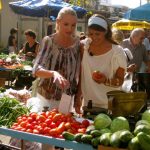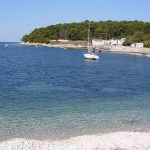When I was a little girl, I lived for three years in a magical little town in Northern Dalmatia, called Trilj. It isn’t of much consequence to anyone unless you happen to have roots there and on my mother’s side we had family living there. I would venture to say it was an idyllic little place but if you didn’t have a connection to it, you were less likely to visit it. It isn’t that far at all, and is located about 40 minutes north of Split on the same road that heads towards Sinj. To get there, you would head in the direction of Sinj and then just turn right at the fork in the road (left would be to go towards Sinj). It’s another 15-17 km east and is located at the confluence of a great bridge over the river Cetina flowing right beneath it and splitting the town evenly in two.
For a small town of about 5,000 – 7,000 people, there is quite a bit to do and see. When I was a child, people would come to Trilj for a festival that takes place every September 30 known as Saint Michael’s Day (or Michaelmas for those familiar with the tradition in England). This is when families who were working abroad – and in Trilj many families had a breadwinner in Austria or Germany, would come to stay for a few days and take part in the festivities honoring the town’s patron saint, Saint Michael. About 20 years ago, a local sculptor living in Zagreb had erected a statue to Saint Michael the Archangel fighting a depiction of the Devil, and it now adorns the front of the church of the same name. The church itself is very lovely and is made of the typical white Dalmatian stone that is frequently seen in this part of the country. I don’t know how old the church actually is but I’d venture it was built in the 1890s given its architectural relief. There is a very large cemetery located next to the church which has gotten bigger and bigger with time, but when I was a small child it was really just the cemetery that is enclosed by the stone walls and which is found next to the small stone chapel that existed back then.
When you cross the bridge over the Cetina river, you will come to the more lively part of Trilj town, and the area known as ‘café row.’ Now, about thirty years ago, or right about the time of the Homeland War, if you had arrived in Trilj or had told someone you were planning to visit it, they would have informed you that there were more cafes than there were people. They would not have been joking. Back then, the town had what must have seemed like hundreds of cafes lining the two narrow sides of the main street which, if you crossed the bridge heading left, went in the direction of the Bosnian border, and if you headed right, you were headed in the southern direction toward the Dalmatian town of Imotski. I remember the cafes very well. My cousins and I must have frequented all of them at some point in our adolescence. Many are gone today and you have about ten left including the most notorious structure further east past the bridge called ‘Carpe Diem’ (borrowing the name from the famous establishment on Hvar). Twenty years ago, however, the place to go and be seen was called ‘Midnight.’ Forget London, Paris and NYC, if you were a Dalmatian youth living in the Zagora region, Midnight was the stuff of legends and so was the then night life in Trilj. I used to hear people say that Sinj, which had a pretty decent café culture, especially around the time of the famous Alka, couldn’t compare to the scene in Trilj. It was so happening that young people from Sinj would drive down to Trilj on a Friday and Saturday night and spend the weekend café hopping there.
But those days now seem like they happened hundreds of years ago and not only twenty-something. The town seems much more quiet and orderly and Carpe Diem has packed in such a punch on two levels, that I wonder how the other cafes can even compete. I visit Trilj at least once a year and usually always when in Split and Sinj, with token relatives still living there.
One of the things that I like about the town of Trilj, is that it is known for two culinary delicacies that are rare to find anywhere else in the country but are found in abundance in the Trilj area, and especially in the river Cetina. These specialties are crayfish and frogs. The locals are also terrific harvesters of escargots and the best place to try all three is the local restaurant located on the other side of the bridge which is still owned by the Klaric family (distant cousins on dad’s side) and which can be found on the first floor of the Hotel Sveti Mihovil.
If you ask for Sime Klaric (the proprietor’s son) he will make sure that you and your party dine on the best river crayfish and frogs to be had anywhere in Dalmatia. I’d start with a hot piping plate of escargots as an appetizer, served with a local cheese and wine (whites from this region being dry and very good). If you are traveling as a pair, an order of crayfish and frogs would be enough for two. For the faint of heart, and those who have never consumed frogs, rest assured that the texture and tone is similar to chicken. I know that sounds like a cliché because when in doubt everything is supposed to taste like chicken, but I was once just like you and terribly sceptical to try river frog only to be surprised by how wonderfully delicious it tastes on the palate. While the crayfish are steamed and sauted, and cooked in white wine, mushrooms, and something like a sour cream sauce, the frogs are breaded and fried, giving them a real Chicken Kiev-like taste.
Apart from this unique culinary delight, Trilj boasts two other reasons to visit. First, it was a Roman garrison town during the third and fourth centuries and there are quite a few roman relics to see and explore. If you hang a right immediately before the town bridge, the road winds past the local school and an old footbridge crossing the Cetina dating back to the 1940s. From here the road winds up a hill to a chapel you would have seen from the side of the main Dalmatian highway. This place is called Gardun and from this vantage point you can see a recently excavated Roman garrison building, which once housed the 4th Roman Legion. I recently saw an episode on HRT1 evening news which unveiled a network of Roman carriage roads that visitors can walk and cross and which extends all the way from Sinj and well past Trilj. Every summer, archaeology students from the University of Zagreb and Split are always working and sifting away near Trilj and can be seen near the bridge area collecting items from the river Cetina.
The stone bridge which many will stop and take photographs of before leaving Trilj is quite well known in Northern Dalmatia. It was erected between the two world wars and prior to its existence people crossed from one side to another through the use of wooden barges. I had seen images of these floating barges in the local post office building located near the church when I was a small child and in books about this area.
Given that this is a town crossed by the river Cetina, Trilj also offers numerous rafting and canyoning opportunities. The river Cetina which originates further upland in Dalmatia near the village of the same name, is very wide at the point in time in which it flows past Trilj and becomes wider, faster, and more dangerous as it exists Trilj just past the village of Caporice where it forms a great basin and plunges into a deep cavern on its way down to Omis and the sea. If you are interested in white water rafting or canyoning, inquire at the Hotel and Sime and his staff will send you in the right direction.
The best time to visit Trilj is in the spring and high summer. Of special interest, is the three-day festival of Sveti Mihovil which lasts from September 28-30 and brings hundreds of thousands of people to Trilj, many of whom live in neighbouring countries and visit primarily to see relatives. There is a carnival atmosphere with rides and attractions and local cheeses, grapes, walnut necklaces known as ‘grotulje’ and other delights available to be tested and tried. The Dalmatian sun is warm and hospitable and its one of the best times to visit this gem of a town located on the river Cetina just forty minutes north of Split.









